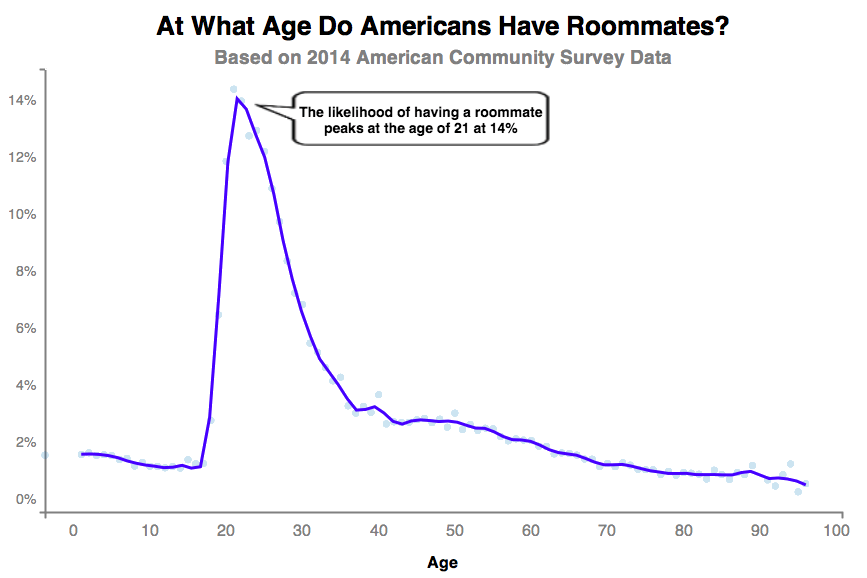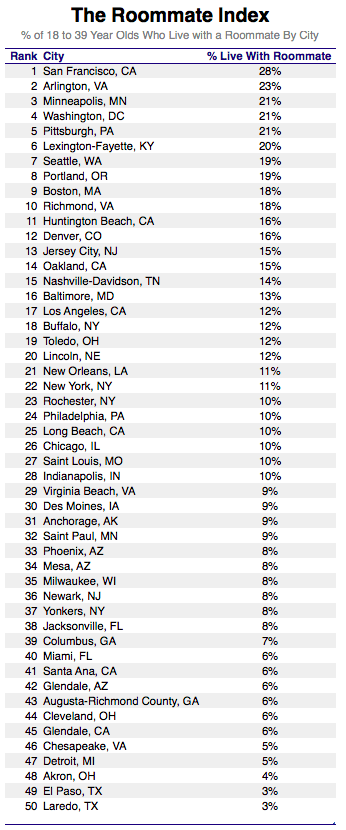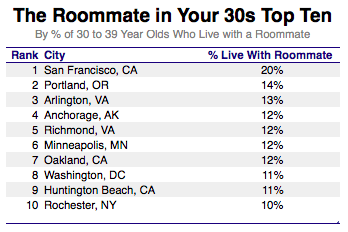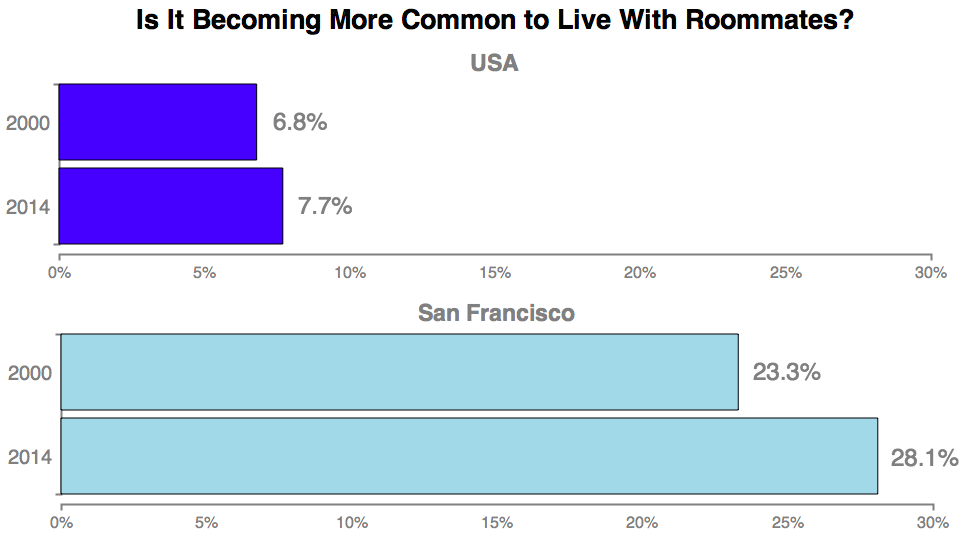The roommate as a normal part of American life is a relatively recent phenomenon.
Fifty years ago a person would typically go straight from living with his or her family to living with a spouse — perhaps with some college in between. Today, it is not unusual to spend the better part of your twenties (or even your thirties) living with people that are neither a family member nor a partner. The living situations of the characters on “Big Bang Theory” and “Friends” would have seemed peculiar to mid-20th century audiences.
Combine increased urbanization, lower marriage rates, later marriage, and increasingly expensive housing costs, and you get a lot of young people willing to live with friends and strangers.
But where exactly — and at what age — do people most commonly have roommates?
America’s Roommate Capital
Using data from the 2014 American Community Survey, we examined the probability of an American resident having a roommate at any given age. Overall, 7.7% of Americans live with a roommate, but as the chart below shows, this likelihood spikes in the early twenties, when many Americans are finished with schooling but not yet coupled up.

Dan Kopf, Priceonomics; Data: American Community Survey
After peaking in the early twenties, the likelihood of having a roommate very quickly declines through the mid thirties, as more people find romantic partners or decide to live alone. From the mid thirties, the proportion of people who have roommates declines more gradually.
In general, the twenties are the pinnacle of roommate living. Across cities, though, there is a wide variation in the percentage of people who live with a roommate at various ages. We analyzed the fifty largest cities in the United States for which the 2014 American Community Survey lists data to find where people between the ages of 18 and 39 are most likely to have a roommate (Some large cities, like Houston and San Diego, are omitted). The estimates in the following list are based on a sample, but are likely accurate within two percentage points.

San Francisco is the roommate capital of the United States. The nation’s highest rents lead young people here to live together at a rate that is more than double the average of the top 50 cities (12%), and 20% higher than second place Arlington, Virginia.
Most of the top cities on the list are relatively expensive cities that are appealing to collegians and recent graduates for a variety of ambitions: San Francisco for tech, Washington DC and Arlington for politics, Minneapolis and Pittsburgh for education, and Portland for early “retirement.”
At the bottom of the list are El Paso and Laredo, two small and affordable cities on the Texas border with large immigrant populations; the post-industrial Midwestern cities of Akron and Detroit closely follow. These are cities that struggle to attract the millennials who are most likely to live with roommates.
The Peter Pan Syndrome
The data above groups together all Americans aged 18 to 39. As we’ve touched on though, there is a wide variance in the percentages of people who live with roommates within these age brackets. While 15% of all Americans aged 20-29 live with a roommate, only 4% of 30-39 year olds do.
We were curious to see where people continue to live with roommates into their thirties more prevalently — the cities where people either can’t afford to grow up or choose not to. Which city is the home of those beset by the Peter Pan syndrome?

Once again, San Francisco comes out on top — and this time, by an even larger margin. One out of every five San Franciscans in their 30s lives with a roommate. This is more than 40% higher than any other city, and almost triple the national average.
At almost every stage of life, San Franciscans are more likely to have roommates. Apparently, this is what happens when median monthly rent for a one bedroom is nearly $3,500. The following chart shows the probability of San Franciscans having a roommate compared to the rest of the United States.

Dan Kopf, Priceonomics; Data: American Community Survey
This huge difference between San Francisco and the rest of the country had us wondering whether the proportion of people with roommates was increasing in San Francisco at a pace faster than the rest of the country.
Using the American Community Survey data, we found that across the entire country, the proportion of people with roommates has increased from 6.8% in 2000 to 7.7% in 2014, a 13% increase. In San Francisco, the roommate rate went from 23.3% to 28.1% in this same period, an increase of 20.6%.
San Francisco has long been the the home of the roommate, and it is becoming even more so.

Dan Kopf, Priceonomics; Data: American Community Survey
Roommates can have profound effects on our lives. Research suggests the behavior of our roommates can have a major impact on our physical and mental health and performance at school or work. They may even affect our tolerance towards those of different backgrounds.
For better or worse, these impacts are becoming more pervasive as living with roommates becomes more common. In no place are they felt more strongly than in the rarefied real estate center that is San Francisco.
Our next post examines the miserable life of the Presidential Turkey. To get notified when we post it → join our email list.
This post was written by Dan Kopf; follow him on Twitter here.



